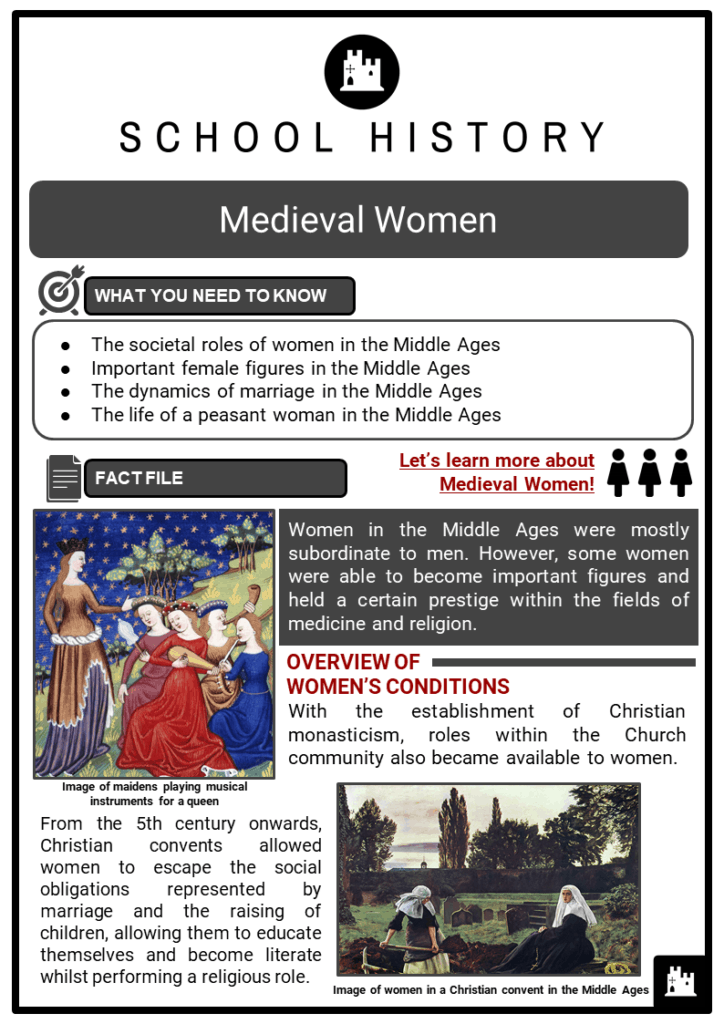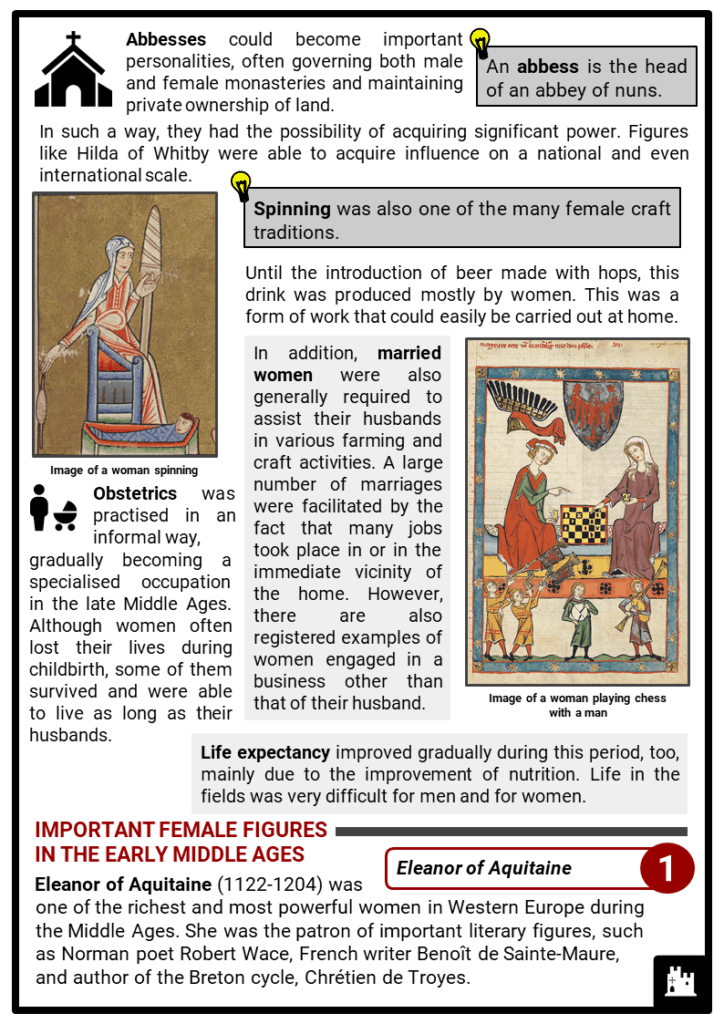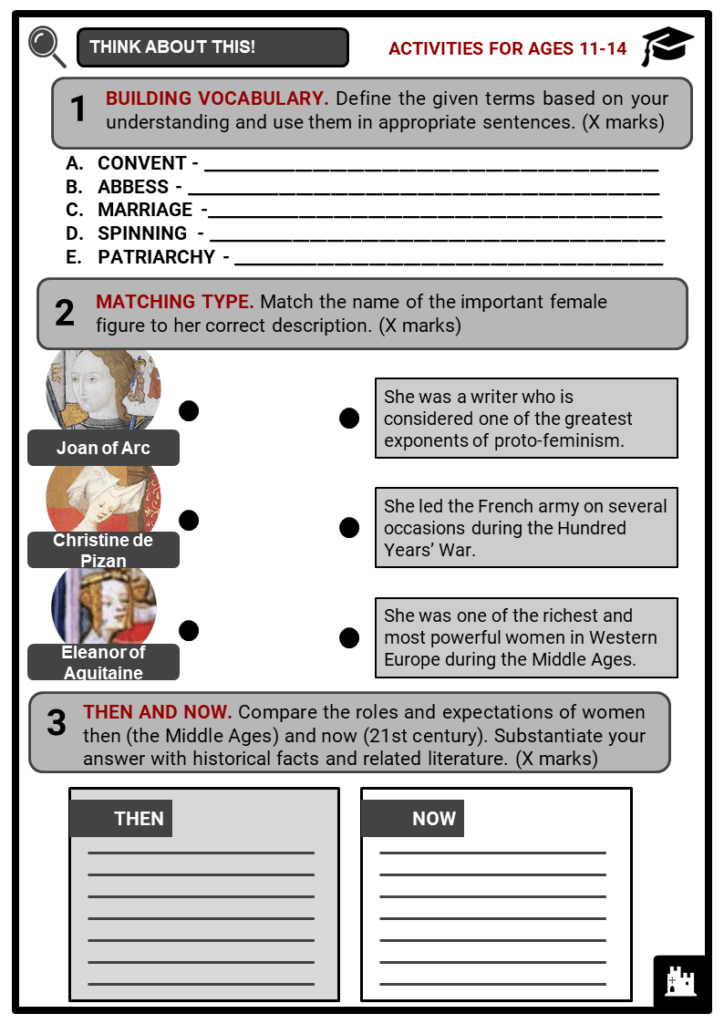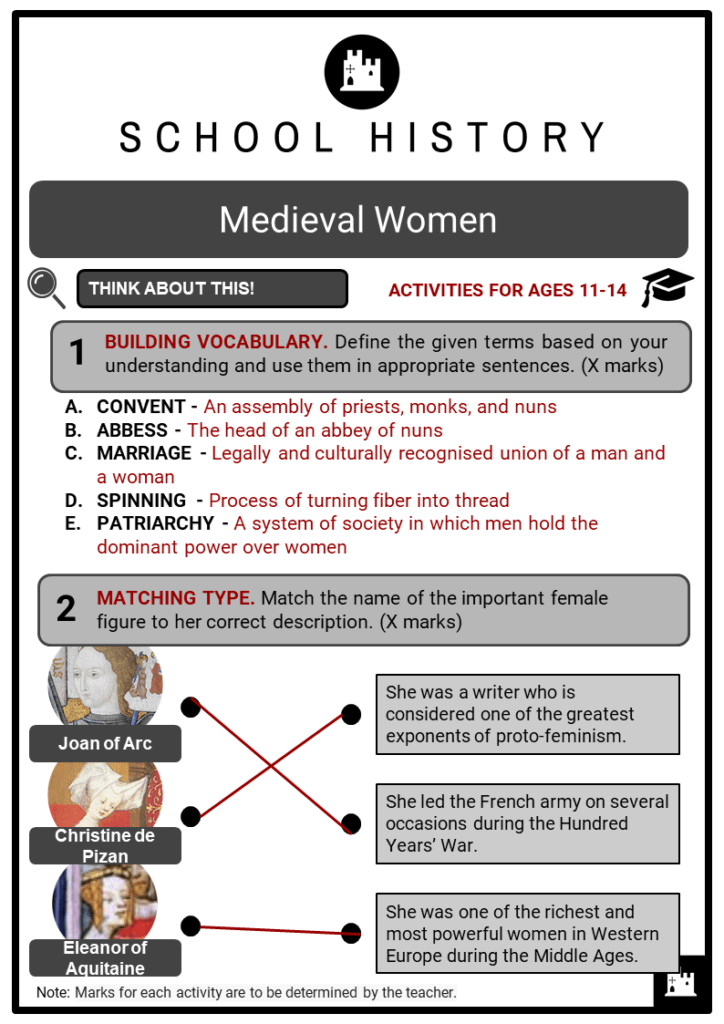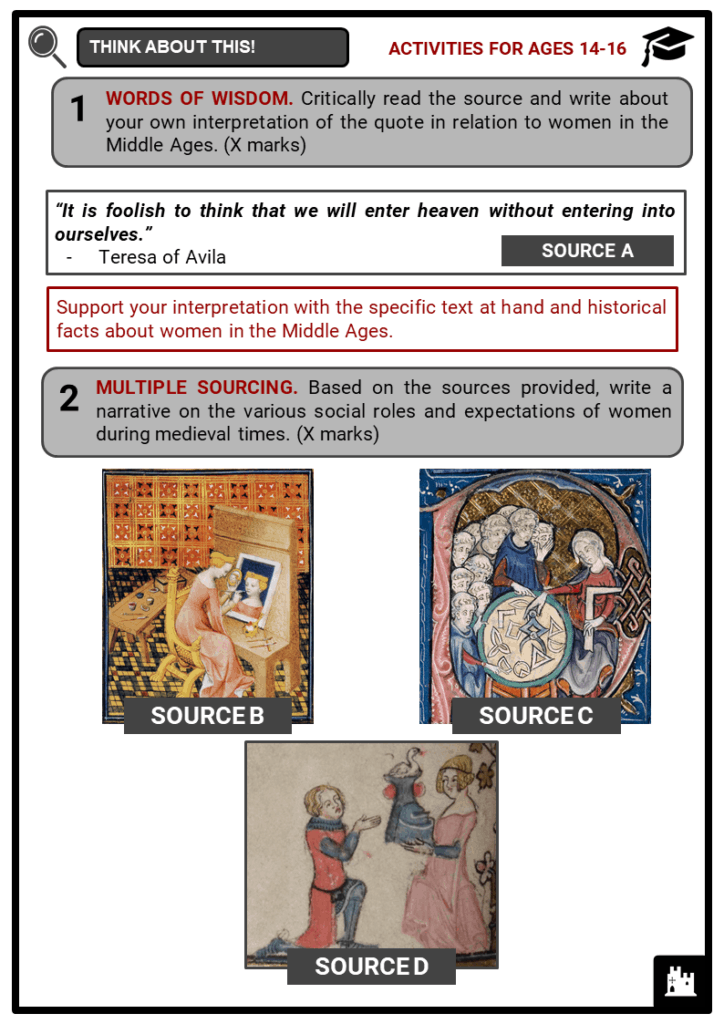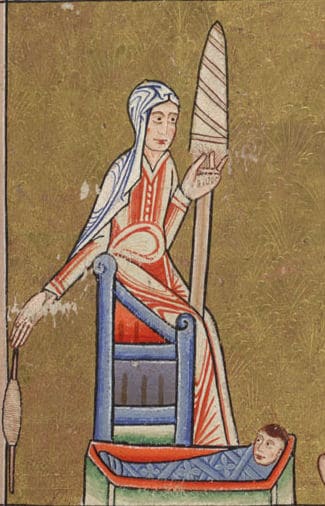Download Medieval Women Worksheets
Do you want to save dozens of hours in time? Get your evenings and weekends back? Be able to teach Medieval Women to your students?
Our worksheet bundle includes a fact file and printable worksheets and student activities. Perfect for both the classroom and homeschooling!
Table of Contents
Add a header to begin generating the table of contents
Summary
- The societal roles of women in the Middle Ages
- Important female figures in the Middle Ages
- The dynamics of marriage in the Middle Ages
- The life of a peasant woman in the Middle Ages
Key Facts And Information
Let’s learn more about Medieval Women!
- Women in the Middle Ages were mostly subordinate to men. However, some women were able to become important figures and held a certain prestige within the fields of medicine and religion.
Overview Of Women’s Conditions
- With the establishment of Christian monasticism, roles within the Church community also became available to women.
- From the 5th century onwards, Christian convents allowed women to escape the social obligations represented by marriage and the raising of children, allowing them to educate themselves and become literate whilst performing a religious role.
- Abbesses could become important personalities, often governing both male and female monasteries and maintaining private ownership of land.
- In such a way, they had the possibility of acquiring significant power. Figures like Hilda of Whitby were able to acquire influence on a national and even international scale.
- Spinning was also one of the many female craft traditions.
- Until the introduction of beer made with hops, this drink was produced mostly by women. This was a form of work that could easily be carried out at home.
- In addition, married women were also generally required to assist their husbands in various farming and craft activities. A large number of marriages were facilitated by the fact that many jobs took place in or in the immediate vicinity of the home. However, there are also registered examples of women engaged in a business other than that of their husband.
- Obstetrics was practised in an informal way, gradually becoming a specialised occupation in the late Middle Ages. Although women often lost their lives during childbirth, some of them survived and were able to live as long as their husbands.
- Life expectancy improved gradually during this period, too, mainly due to the improvement of nutrition. Life in the fields was very difficult for men and for women.
Important Female Figures In The Early Middle Ages
- Eleanor of Aquitaine
- Eleanor of Aquitaine (1122-1204) was one of the richest and most powerful women in Western Europe during the Middle Ages. She was the patron of important literary figures, such as Norman poet Robert Wace, French writer Benoît de Sainte-Maure, and author of the Breton cycle, Chrétien de Troyes.
- Eleanor succeeded her father at the age of 15, thus, becoming the most desirable bride of the entire European continent.
- Abbesses and Authors
- Herrad von Landsberg, Hildegard of Bingen, and Héloïse d’Argenteuil were abbesses and influential authors of this period. The mystical Flemish poetess, Hadewijch, also became popular during the 12th and 13th centuries. Both Ildegarda and Trotula de Ruggiero were writers and experts in medical arts during the 12th century.
- Powerful in Politics
- Constance of Altavilla (1154-98), Urraca of Castile (1080-1126), Joanna I of Navarre (1273-1305), and Melisende of Jerusalem (1105-61), among others, exerted political power.
Powerful Women In The Late Middle Ages
- Virdimura
- Virdimura was a Catanese Jew, and she is considered an important figure in historical medical literature. Thanks to the laws of Frederick II,
- she was able to study medicine in Catania after 1300. Virdimura became the first woman in history to obtain a degree in medicine on 7 November 1376. Her degree is kept in the State Archive of Palermo. Virdimura dedicated herself to taking care of the women, as well as the poor and needy. Her medical licence allowed her to carry out these tasks. Being Jewish, Virdimura was educated in food discipline and personal care according to the ancient Jewish precepts.
- Isabella of Castile
- In fact, medicine had a period of exceptional splendour in Sicily before 1492. Yet, an edict of 18 June 1492, proclaimed by the sovereigns of Spain, Isabella of Castile and Ferdinand II of Aragon, expelled the Jews from the country. French bourgeois women were also educated.
- Isabella of Castile (1451-1504) reigned with her husband Ferdinand II of Aragon following the Unification of Spain.
- Saints and Doctors of the Catholic Church
- In the Middle East, women like Catherine of Siena (1347-80) and Teresa of Avila (1515-82) played a significant role in the development of theology and discussions within the Church. They were later declared saints and doctors of the Roman Catholic Church. Even the mystic Julian of Norwich (1342-1416) assumed a prominent role in England.
- Female Leaders and Pioneers
- Joan of Arc (1412-31) successfully led the French army on several occasions during the Hundred Years’ War.
- Christine de Pizan (c. 1354-1430) was a well-known, late medieval writer. She dealt with women’s issues and is still considered one of the greatest exponents of proto-feminism.
- Her book, The City of the Ladies, attacked the general misogyny of society of her time, while her work, Le trésor de la cité des dames, articulated an ideal of feminine virtue for all women on different paths of life, which ranged from the peasant’s wife up to princesses.
- Her advice to the princesses also included the recommendation of using their diplomatic skills to prevent wars.
- To summarise, she stated that if a neighbour or a foreign prince wanted to make war against her husband for whatever reason, or if her husband wished to make war, a proper lady would consider this carefully.
- She would take into account the great evils and the endless cruelties, destruction, massacres, and the general damage of the war. Since the outcome was often terrible, she would ponder ways in which she could prevent the war while maintaining her husband’s honour.
- Starting from the last century of the Middle Ages, various restrictions began to be put on employment and guilds, resulting in occupations becoming more and more exclusively male. Some of the reasons this happened could be the growing status and political role played by the guilds and the increasing competition carried out by cottage industries, which led guilds to restrict their entry requirements. Finally, even the rights of female private property ownership began to be reduced.
Marriage
- According to the Catholic code of canon law, marriage was considered an exclusive concrete link between a husband and wife. However, it assigned to the husband all the power and control in the relationship. The husband and wife were partners, and they were the reflection of Adam and Eve. However, wives had to submit to marital authority. They still managed to maintain certain rights, though. In fact, both women and men shared sexual and marriage rights, which included the right to consent to marriage, the right to marital duties, the right to leave a marriage when suspected of being invalid or to challenge the separation when there was a valid reason, and the right to choose one’s place of burial.
- Marriages could be carried out in secret by the couple, or they could be organised between families so that the man and woman were, in certain cases, forced to consent. However, in the 12th century, in the canonical western law, mutual consent between the couple remained imperative. Marriages confirmed in secrecy were considered problematic in the legal sphere. For example, it was problematic for those who intended to have it annulled by denying that it had ever been consumed.
- Peasant women, slaves, and servants, in general, needed the permission of their master to be able to marry. Various punishments were enforced if such a rule was broken. Marriage also allowed the couples’ social network to expand.
Peasant Women
- Medieval society was essentially governed by patriarchy, and women were subjected to male control regardless of their social class.
- In fact, the life of a peasant woman was enveloped by prohibition and general limitation imposed by the opposite sex. Women had to submit first to their father or to the male breadwinner of the house. Later, if married, they were subjected to their husband, under whose control she remained for the rest of her life.
- English peasant women generally could not maintain ownership of land for a long time. They rarely learned an artisan occupation and even more rarely advanced beyond the position of assistant. They could never become public officials.
- Peasant women were subject to numerous restrictions imposed by their feudal lords regarding their behaviour.
- If a woman became pregnant without being married or had had sexual relations outside of religious marriage, the lord was entitled to compensation.
- Even without a feudal lord involved in her life, a woman was still supervised by her father, siblings, or other male family members. Women always had very little control over their lives.
- The control of peasant women involved considerable financial advantages for the lords. This was not motivated by the social status of women, since sexual activity was not rigidly regulated. There were couples who simply cohabitated and did not undergo any formal ceremony. However, this was allowed only if the lord had given his consent.
- Some women who managed to maintain their property rights enjoyed a particular immunity. Moreover, some businesses (such as the production of beer) provided some independence to women workers.
- In medieval Western Europe, society and economy were essentially rural. 90% of the European population lived in the countryside or in very small towns. Agriculture played an important role in supporting this type of economy, and due to the lack of mechanical devices, activities were carried out mainly by hand.
- Both men and women participated in the medieval labour force, and most of the workers were never paid through a salary. In fact, they almost always worked independently on their own land and produced the goods needed for their own consumption. Although peasant women worked as hard as men, they suffered many disadvantages, such as having less property, experiencing various professional exclusions, and lower earnings if they ever dealt with other people’s land.
Image sources:
[1.] https://upload.wikimedia.org/wikipedia/commons/3/36/Medieval_women_hunting.jpg
[2.] https://upload.wikimedia.org/wikipedia/commons/5/5b/Isabel_I_of_Castile.jpg
[3.] https://upload.wikimedia.org/wikipedia/commons/7/76/Hunterian_Psalter_c._1170_Eve_spinning.jpg

